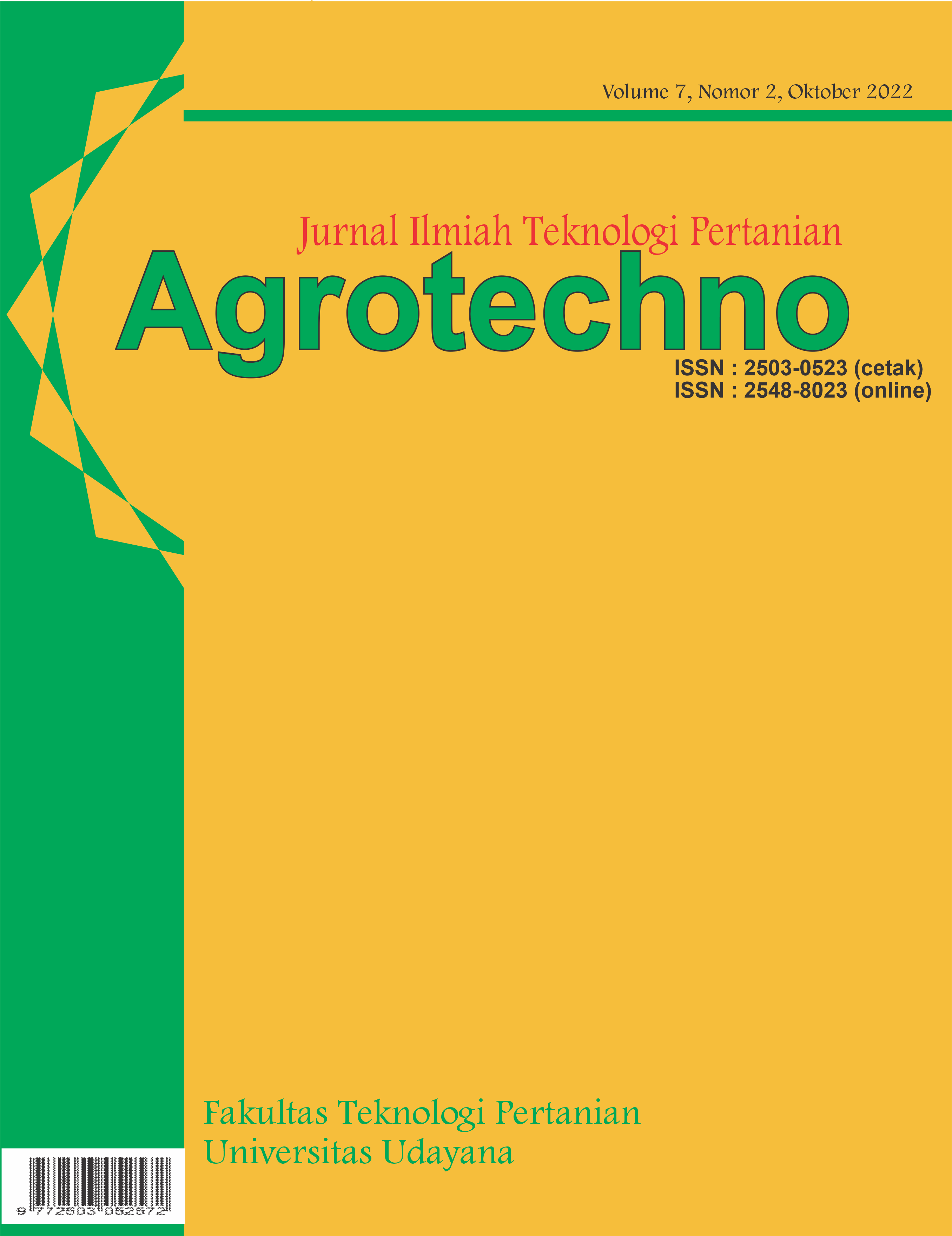Karakteristik Bubur Instan Berbasis Ubi Jalar Kuning dan Tempe
Abstract
Instant porridge is a practical food processed product that is easy for people to consume and has a soft texture and easy to digest. The purpose of this research was to get the best formulation of yellow sweet potato and tempeh on the chemistry characteristics and sensory characteristics of instant porridge. The research method used a completely randomized design with five treatments and three replications. The treatments used yellow sweet potato and tempeh with variation treatment: JT1 (yellow sweet potato and tempeh 90:1), JT2 (yellow sweet potato and tempeh 80:20), JT3 (yellow sweet potato and tempeh 70:30), JT4 (yellow sweet potato and tempeh 60:40), and JT5 (yellow sweet potato and tempeh 50:50). The data obtained were statistically analyzed using analysis of variance and continued with Duncan's Multiple Range Test (DMRT) at the 5% level. The results showed that the combination of yellow sweet potato and tempeh significantly affected moisture, ash, fat, protein and carbohydrate content. Based on the result of this research, the combination of yellow sweet potato and tempeh 90:10 was chosen as the best treatments: moisture content 7.79%, ash content 4.66%, fat content 3.28%, protein content 8.97% and carbohydrate content 76.68%.
Downloads
References
Anandito, R. B. K., Siswanti, dan D. T. Kusumo. 2016. Kajian Karakteristik Sensoris dan Kimia Bubur Instan Tepung Millet Putih (Panicum miliaceum L.) dan Tepung Kacang Merah (Phaseolus vulgaris L.). Jurnal Teknologi Hasil Pertanian. 9(1): 17-23.
Andarwulan, N., F. Kusnandar. dan D. Herawati. 2011. Analisis Pangan. PT Dian Rakyat, Jakarta.
Arham, Z., Kurniawan, L. Anhusadar, dan Ismaun. 2021. Spectroscopic Analysis of Tempeh Protein Content during the Production Process. International Journal of Transdisciplinary Knowlegde. 69-81.
Badan Standardisasi Nasional. 2012. Tempe: Persembahan Indonesia untuk Dunia. Badan Standardisasi Nasional, Jakarta.
Barus, T., H. N. Griselda, A. Suwanto, and A. W. Tan. Metagenomic Analysis of Bacterial Diversity in Tempe using Terminal Restriction Fragmen Length Polymorphism (TRFLP) Technique. Biota 15. 80-273.
Handajani, S., E. Nurhartadi, dan I. N. Hikmah. 2011. Kajian Karakteristik Kimia dan Sensori Tempe Kedelai (Glycine max) dengan Variasi Penambahan Berbagai Jenis Bahan Pengisi (Kulit Ari Kedelai, Millet (Pennisetum spp.)), dan Sorgum (Sorghum bicolor)). Jurnal Teknologi Pangan Hasil Pertanian. 4(2): 135-142.
Hasyim, A. dan M. Jusup. 2008. Diversifikasi Produk Ubi Jalar sebagai Bahan Pangan Substitusi Beras. Sinar Tani Edisi 30 Juli-5 Agustus 2008.
Hastuti, I. T., D. Rachmawanti, dan D. Istaryani. 2014. Kajian Sifat Fungsional dan Sensoris Cake Ubi Jalar Kuning (Ipomoea batatas L.) dengan Berbagai Variasi Perlakuan. Jurnal Teknosains Pangan 3(1):74-83.
Kasmidjo, R. B. Tempe Mikrobiologi dan Biokimia Pengolahan serta Pemanfaatannya. PAU Pangan dan Gizi, Yogyakarta.
Mahmud, M. K., Hermana, Nazarina, Marudut, S., N. A. Zulfianto, Murhayatun, A. B. Jahari, D. Permaesih, F. Ernawati, Rugayah, Haryono, S. Prihatini, I. Raswanti, R. Rahmawati, D. Santi P., Y. Permanasari, U. Fahmida, A. Sulaeman, N. Andarwulan, Atmarita, Almasyhuri, N. Nurjanah, N. Ikka S., G. Sianturi, E. Prihastono, dan L. Marlina. 2018. Tabel Komposisi Pangan Indonesia. Direktorat Jenderal Kesehatan Masyarakat. ISBN 987-602-416-407-2.
Marczak, B.K., B. Sawicka, J. Supski, T. Cebulak, and K. Paradowska. 2014. Nutrition Value of the Sweet Potato (Ipomoea batatas (L.) Lam) Cultivated in South-Eastern Polish Conditions. Internation Journal of Agronomy and Agricultural Research. 4(4):169-178.
Muchtadi, T. R. dan Sugiyono. 2013. Prinsip Proses dan Teknologi Pangan. Alfabeta. Departemen Ilmu dan Teknologi Pangan Faperta. Institut Pertanian Bogor. Bogor.
Palijama, S., R. Breemer, dan M. Topurmera. 2019. Karakteristik Kimia dan Fisik Bubur Instan Berbahan Dasar Tepung Jagung Pulut dan Tepung Kacang Merah. Agritekno. 9(1): 20-27.
Rosidah. 2014. Potensi Ubi Jalar sebagai Bahan Baku Industri. Teknobuga. 1(1) : 44 - 52.
Sugito, W. Manalu, D. A. Astuti, E. Handayani, dan Chairul. 2006. Histopatologi Hati dan Ginjal pada Ayam Boiler yang Dipapar Cekaman Panas dan Ekstrak Kulit Batang Jaloh (Salix tetrasperma Roxb.). Jurnal Ilmu Peternakan dan Veteriner. 12((1): 68-73.
Tamrin, R dan S. Pujilestari. 2016. Karakteristik Bubur Bayi Instan Berbahan Dasar Tepung Garut dan Tepung Kacang Merah. Konversi. 5(2): 49-58.
Tang, J., H. Feng, and G. Q. Shen. 2003. Drum drying di dalam Encyclopedia of Agricultural, Food, and Biological Engineering. Marcel Dekker, Inc. New York.
Utari, D. M. 2010. Kandungan Asam Lemak, Zinc, dan Copper pada Tempe, Bagaimana Potensinya untuk Mencegah Penyakit Degeneratif? Gizi Indon 2010. 33(2): 108-115.
Winarno, F. G. 2008. Kimia Pangan dan Gizi. PT Gramedia Pustaka Utama. Jakarta.
Yuliana, N., Y. B. Pramono, dan A. Hintoro. 2013. Kadar Lemak, Kekenyalan, dan Cita Rasa Nugget Ayam yang Disubstitusikan dengan Hati Ayam Broiler. Animak Agriculture Journal. 2(1): 301-302.
Yulianti. 2018. Penambahan Tepung Ikan Cakalang sebagai Sumber Protein pada Pembuatan Bubur Talas Instan. Jurnal Galung Tropika. 7(3): 169-174.










